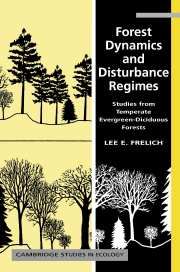Book contents
- Frontmatter
- Contents
- Preface
- Acknowledgements
- 1 The forest setting
- 2 The disturbance regime and its components
- 3 Sampling and interpretation of stand disturbance history
- 4 Disturbance, stand development, and successional trajectories
- 5 The study of disturbance and landscape structure
- 6 The disturbance regime and landscape structure
- 7 Disturbance in fragmented landscapes
- 8 Forest stability over time and space
- References
- Appendix 1
- Index
3 - Sampling and interpretation of stand disturbance history
Published online by Cambridge University Press: 11 August 2009
- Frontmatter
- Contents
- Preface
- Acknowledgements
- 1 The forest setting
- 2 The disturbance regime and its components
- 3 Sampling and interpretation of stand disturbance history
- 4 Disturbance, stand development, and successional trajectories
- 5 The study of disturbance and landscape structure
- 6 The disturbance regime and landscape structure
- 7 Disturbance in fragmented landscapes
- 8 Forest stability over time and space
- References
- Appendix 1
- Index
Summary
Introduction
The previous chapter provided general background information on how disturbances work in the forest. This chapter shows how to detect and measure the impact that disturbances discussed in Chapter 2 have upon the forest at the individual tree and stand scale (1–10 ha). Chapter 4 follows with a synthesis of stand dynamics in the Great Lakes forests, obtained using the methods presented in this chapter. Thus, this pair of chapters (3 and 4) presents methods for studying stand dynamics and then the results of application of those methods to the Great Lakes forest. Chapters 5 and 6 form a similar pair of methods/applications but at the landscape scale.
Here I start with discussion of the different types of evidence on stand disturbance history, then proceed to show how to use such evidence to construct a disturbance chronology which chronicles the occurrence of disturbance and its impact on stand structure for the last few centuries. Much of the chapter is devoted to interpreting tree rings for stand history and dealing with the various problems that are inherent in these methods. The importance of choosing a sampling scheme (i.e. the all-important question of which trees to core) that matches the objectives of a given study is another important topic discussed below.
Use of stand data for interpretation of stand history
Several lines of field evidence are available to those investigating stand history. They provide different levels of detail, time resolution, and types of information about stand history (Table 3.1).
- Type
- Chapter
- Information
- Forest Dynamics and Disturbance RegimesStudies from Temperate Evergreen-Deciduous Forests, pp. 44 - 89Publisher: Cambridge University PressPrint publication year: 2002

